8
José Luis Rodríguez Zapatero became Prime Minister (presidente) as the result of the Socialist victory in the general election. His campaign slogan was ‘el nuevo talante’ (‘the new attitude’) and he set about putting it into practice from day one. His personality was conciliatory and unpretentious in opposition to Aznar’s often confrontational and arrogant attitude.

One of Zapatero’s promises during his campaign was to bring back home the Spanish troops deployed in Iraq, and he did so within weeks after his inauguration. Eleven Spanish soldiers had already died in the conflict.
He was also highly invested in gender equality issues. He maintained 50% female representation in his cabinets, and appointed women to particularly important portfolios such as Deputy PM (vicepresidenta), Finance Minister (ministra de Economía) and Defence Minister (ministra de Defensa).
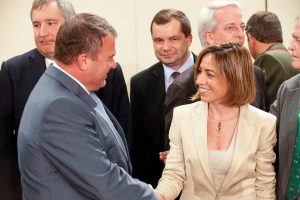
8.1 ‘EL NUEVO TALANTE’: SOCIAL REFORMS
During his first mandate, Zapatero’s government introduced a series of laws that put Spain in the vanguard of Europe regarding social reforms.
Immediately after the election the Gender Violence Act (Ley Integral contra la Violencia de Género) was passed in Parliament. All MPs voted in favour. Violence (physical, psychological and sexual) against women by their partners or ex-partners is a general problem all over the world. From the late 1990s onwards, the Spanish media had been focusing their attention on this type of crime and, consequently, a growing sense of outrage was taking hold of the general public opinion. The Socialists sensed this mood in the public and decided to act.
Every year an average of 50 to 60 women get murdered in Spain by their husbands, ex-husbands, boyfriends or ex-boyfriends. One out of three murdered women are foreign nationals. The law put in place the provision to create over 100 special courts to deal exclusively with crimes of violence against women. In this way, barring and electronic tracking device orders would be issued promptly and culprits would be tried and sentenced more rapidly. Thanks to this law, threatened women and their children have a right to apply for financial aid to help them move to a different town. Undocumented immigrant women under threat of gender violence are entitled to be fast-tracked for a residence and work permit, which allows them to leave their abusive partners. Tougher sentences were introduced and a provision for rehabilitation courses was made so that perpetrators were not only punished, but also integrated back into society after serving their sentences.
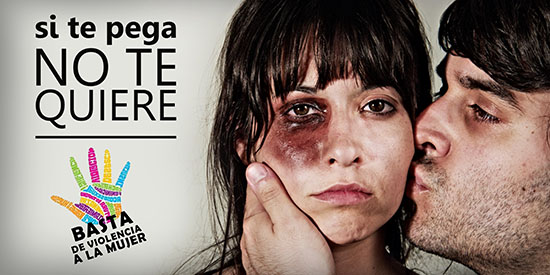
Detractors of the law point out that it discriminates against men, since only crimes of violence against women are recognized as gender violence in this law. However, experience and statistics clearly point to the fact that gender violence overwhelmingly affects women and that is clearly a consequence of a structurally patriarchal society, not only in Spain, but also Europe and the rest of the planet. This is probably the reason why the Gender Violence Act has failed to reduce the number of women murdered at the hands of their partners. It seems that only a complete change of social attitudes towards women may have any positive impact. Another criticism against the law is that it has allegedly led to an increase in false accusations of gender violence. As far as the statistics show, the number of false formal complaints is insignificant (between 2009 and 2016 there were over one million formal complaints and only 79 turned out to be false, according to El País).
CULTURAL RESOURCES
Estadísticas de víctimas mortales por violencia de género (Instituto de la Mujer y para la Igualdad de Oportunidades, Gobierno de España)
El orden de las cosas (short film against gender violence) (Spanish with English subtitles)
FILM
Te doy mis ojos (2003) (available from the library) Drama about a woman suffering domestic violence.
The new Divorce Act, passed in 2005, was designed to speed up the process of obtaining a divorce. The new law allows couples to file for divorce as early as three months after their marriage, even earlier in case of gender violence. There is no need for a period of legal separation and citing grounds is not required. If there are no complications a couple can get divorced in two months.
Also in 2005 gay marriage was legalised. Spain was the third country in the world to do so, after the Netherlands (in 2001) and Belgium (in 2003). The Same-Sex Marriage Act grants homosexual married couples equal rights to heterosexual ones, including the adoption of children. This law was a blow to traditional sections of Spanish society, and the PP and some sectors of the Spanish Catholic Church organised several rallies to protest against it. The PP took it to the Constitutional Court, which finally ruled in favour of the law in 2012.
In 2006 the Dependency Act (Ley de Dependencia) was introduced with the aim of improving the social conditions of people with disabilities and their carers. There was a provision to create helplines, home-help services and day centres. In the same year, the government created the so-called ‘cheque bebé’, a financial incentive to boost the country’s low birth rate. It consisted of a €2,500 payment to parents of newly born or adopted children.
Another ground-breaking law was passed in 2007: the Effective Equality Act (Ley para la Igualdad Efectiva de Mujeres y Hombres). The law contained a series of provisions to target gender inequality in society. It established measures to combat sexual harassment and discrimination, especially at work. Corporations were required to achieve 40% female representation on their boards of directors by 2015. This measure turned out to be more aspirational than realistic. At the moment, female representation on company boards is around 10%. There seems to be a ‘glass ceiling’ for women that is proving very resistant, regardless of how well-prepared and talented some women are. 40% is also the figure established for female representation in political parties’ electoral lists.
In order to foster equal responsibility between parents in the upbringing of their children, the Effective Equality Act also implemented a 2-week paternity leave with a view to gradually increase it. From January 1st 2021 paternity leave was extended to 16 weeks, making it equal to maternity leave.
Towards the end of the Socialist mandate, in 2010, a new abortion law was introduced (Ley del Aborto). This was a law based on time limits for the termination of unwanted pregnancies, instead of being based on conditions like the previous law. The 1985 Abortion Act (implemented by Felipe González’s government) limited terminations to cases of rape, malformation of the foetus and serious danger to the mother’s physical or mental health. The 2010 Abortion Act has made terminations available without any conditions up to the 14th week of pregnancy, and up to the 22nd week in cases of risk to the mother’s health or malformation of the foetus. Those underaged of 16 to 17 do not need parental permission to terminate their unwanted pregnancies, but at least one parent or legal tutor must be informed. In 2013, with the PP back in power, the Justice Minister tried to change the law to one based on even more restrictive conditions than the 1987 act (the condition of malformation was excluded). However, he encountered firm opposition in the general public opinion, and even within his own party, and was forced to withdraw his proposal and resign from his position.
8.2 MEMORY AND JUSTICE
We have already mentioned the Historical Memory Act (Ley de la Memoria Histórica) that came into force in 2007, recognising the need to exhume the mass graves dating from the Civil War and its aftermath in order to achieve a full closure based on truth and reconciliation. It proved to be a very controversial law to pass and was rejected by the opposition party, the PP, which has always been unwilling to criticise the military uprising against the Republic and the ensuing dictatorship.
The past had even more dark secrets to reveal. Between 2009 and 2010 the scandal of the ‘stolen babies’ broke out. It referred to an illegal adoption racket which started during Francoism and continued well into the democratic period. During the dictatorship, the regime with the Catholic Church’s collusion conspired to take away babies and children from their ‘politically unfit’ parents, i.e. people on the Republican side during the Civil War, to be raised by parents that could provide a Catholic and Francoist education. What started as a policy of political cleansing and re-education continued over decades as a lucrative business.
An estimated 300,000 new-borns were taken away from their mothers and sold to other families between 1940 and 1990. Mothers were told that their babies had been stillborn or that they had died shortly after birth. Doctors, midwifes, nurses, priests and nuns were involved in these transactions. This practice took place all over Spain both in public and private hospitals.
At the moment several associations are dealing with this issue, trying to match biological parents and grown-up children separated for decades and gathering information to bring the alleged perpetrators to justice. There is little hope about culprits standing trial since some have already died and many cases have fallen under a statute of limitations due to the long time elapsed.
CULTURAL RESOURCES
Reconstructing Spain. Memory and Meaning (short documentary in English and Spanish with English subtitles)
Spain’s Stolen Babies (BBC2, in English)
8.3 ETA: THE END IS NEAR
ETA declared a permanent ceasefire in 2006. Zapatero was ready to enter into dialogue with the terrorist organisation, already quite weakened, even if the PP criticised him in very harsh terms, accusing him of ‘betraying the victims’. Things did not run smoothly and at the end of the year ETA planted a bomb in the car park in Madrid Airport. Although they issued a warning that allowed the terminal to be evacuated, two Ecuadorian nationals, who were sleeping in their cars at the time of the explosion, were killed. Any hopes of negotiation disappeared. Police investigations and arrests increased, debilitating ETA even further.
At the same time, the Basque Nationalist Left, ETA’s political arm, had started to seriously question the armed struggle as a means to achieve independence. The example of the peace process in Northern Ireland was ever-present. They decided to turn to international mediators in order to facilitate a unilateral peace process. In October 2010 an international peace conference, organised by the Basque Nationalist Left, was held in San Sebastian, in the Basque Country. The conference was attended, amongst others, by former UN Secretary-General Kofi Annan, ex-Taoiseach Bertie Ahern and Sinn Féin leader Gerry Adams. There were no representatives of the Spanish government. Three days later ETA announced the ‘definite end of its armed actions”, although, at the time, it did not mention any intention of disbanding or disarming. This was the first real step towards the end of ETA.
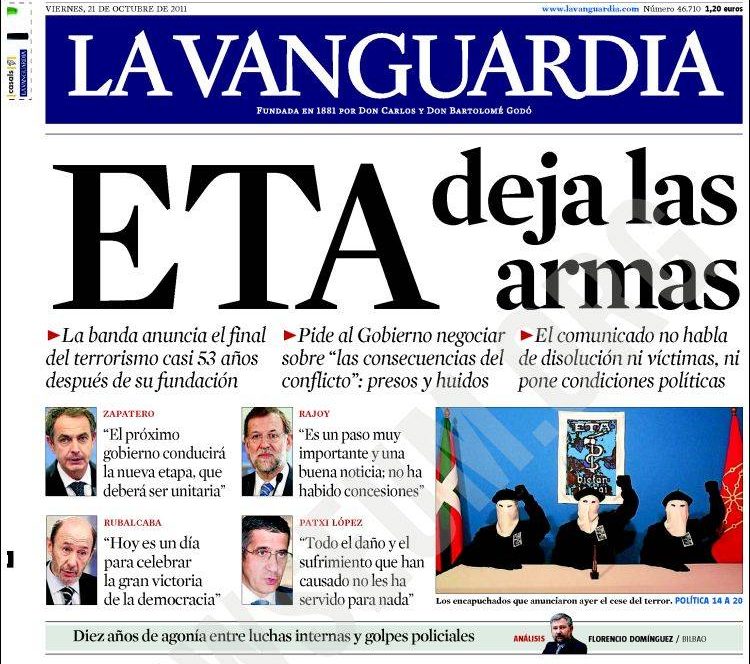
CULTURAL RESOURCES
Aiete Peace Conference (San Sebastian, Basque Country). Ex-Taoiseach Bertie Ahearn reads the final declaration. (in English with Basque subtitles)
FILM
Bomb Scared (Fe de etarras, 2017) (Netflix) Spanish comedy about a dysfunctional ETA cell planning an attack during the 2010 World Cup.
8.4 THE BUBBLE BURSTS
In 2008 the world economy entered a recession due to the credit crisis caused by the ‘subprime’ mortgage market. The so-called ‘credit crunch’ initiated in the US with the collapse of such a reputable financial institution as Lehman Brothers. Banking bailouts followed in the US and Britain. Some Eurozone countries could not repay their public debt and had to be bailed out by the ECB (European Central Bank) and the IMF (International Monetary Fund): Greece and Ireland in 2010, Portugal in 2011. Even so, Zapatero did not believe Spain’s economy was in trouble. It took a couple of years for him to acknowledge that Spain was also in recession. His delay in admitting the problem and acting earlier is probably his biggest mistake as a leader.
As we have mentioned before, the Spanish economic success that started in the late 1990s was caused by the boom in construction fuelled by historically low interest rates. Most jobs created during this period were related to the construction industry. The easy access to mortgages created a huge speculation in the property market; house prices grew exponentially. It was clear that the housing bubble was growing to such a point that it was bound to burst. And so it did. People stopped buying houses and investing in properties, building ground to a halt, developers went into receivership, jobs were lost. Many people could not afford their mortgage repayments any longer and evictions started.
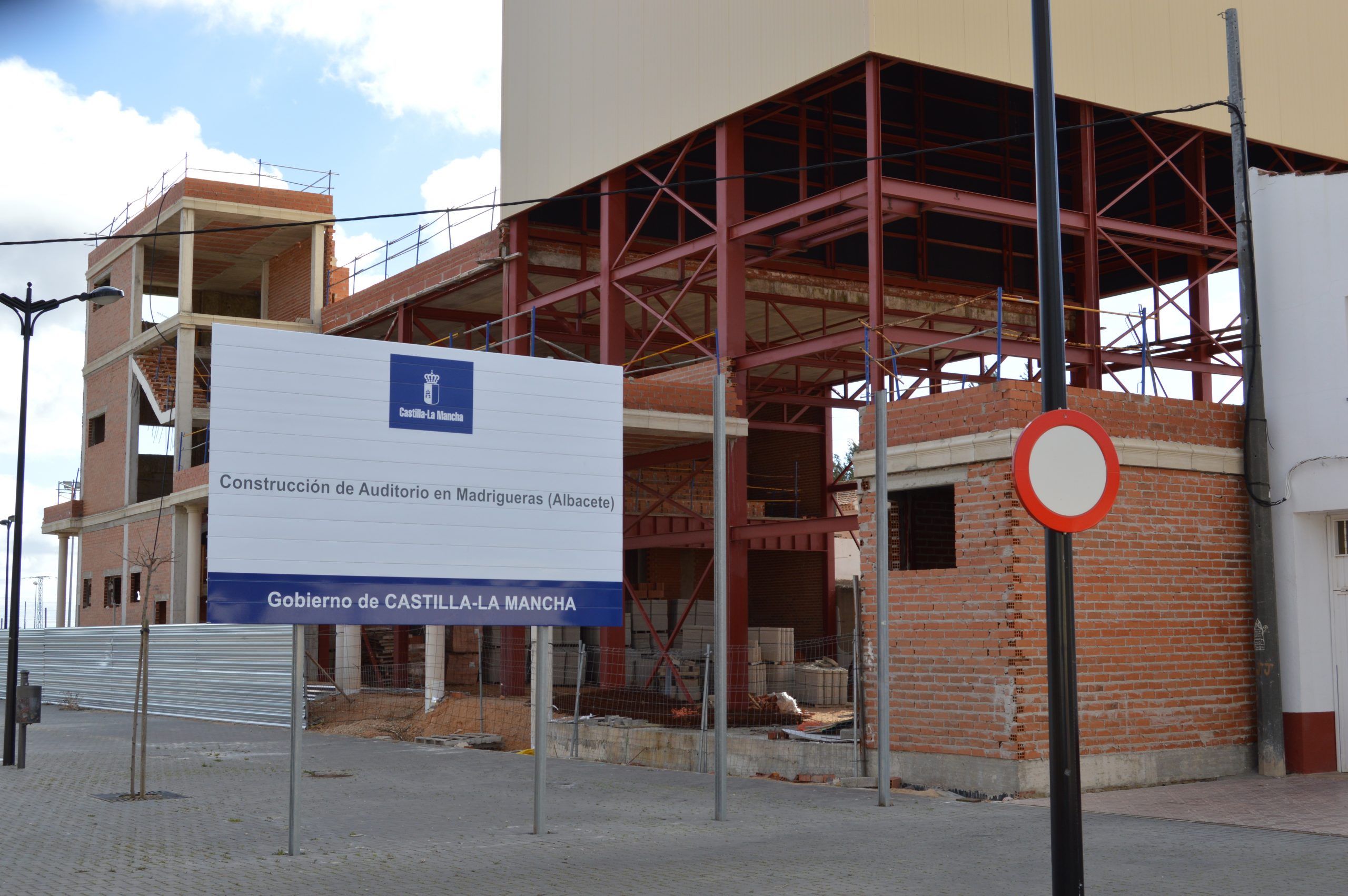
The economic downturn created important social problems. Unemployment rose from 8% in 2007 to 20% in 2010. Many families lost their home due to defaulting on their mortgage repayments and they had to move back with their elderly parents, and there were some cases of suicide committed by people who were about to be evicted. Young people, especially university graduates and post-graduates, left Spain in the hundreds of thousands in search of employment abroad. Spain was losing its future.
Finally, Zapatero, against his political beliefs, had to start implementing the painful measures he had been avoiding and that the EU was demanding. In order to reactivate the labour market a reform was introduced that made it easier for employers to lay off workers and penalised permanent contracts. Adjustments, also called ‘austerity measures’, had to be made in order to curtail the public deficit: the ‘cheque bebé’ disappeared, civil servants’ salaries were reduced, old-age pensions were frozen, the pharmaceutical expenditure in the public health sector was cut back and VAT increased.
Immigrants, who had arrived in the times of bonanza, were no longer an asset. In 2005 Zapatero had given all irregular foreign residents in Spain a controversial amnesty which allowed them to obtain permits. With this measure around 700,000 undocumented immigrants entered the system and increased the Social Security contributions by €1 billion that year. When the economy started to slow down, many immigrants lost their jobs and the government wanted to encourage them to leave Spain. The Volunteer Return Plan was introduced at the end of 2008. Foreigners who had lost their jobs and wanted to return to their countries would get the unemployment benefit due to them in two instalments: 40% in Spain and 60% in their home country. They had to give up their residence and work permits and were not allowed to return to Spain for three years. Only a small number of immigrants took up this offer.
CULTURAL RESOURCES
Españistán: Spanish housing bubble explained (comic animated short film in Spanish with English subtitles)
Cutting Back: Spain Hit Hard Times (Wall Street Journal (December 2011)) (in English)
8.5 15-M: THE ‘INDIGNADOS’
On May 15th 2011 a series of rallies were organised in different Spanish cities. The protesters, representing a wide section of Spanish society, were blaming politicians for the handling of the economic crisis, especially the implementation of austerity measures with cutbacks in health, education and social benefits. They wanted to voice their rejection of a political system that they did not consider a real democracy, based on two parties alternating in power that were deeply involved in corruption cases and were more interested in serving the interests of banks and big corporations rather than looking after their citizens. In Madrid around 50,000 people demonstrated and decided to occupy the Puerta del Sol, right in the heart of the capital. They set up camp there for nearly one month, protesting, debating different courses of action in mass assemblies and inspiring the wider public to think about achieving a society in which people and the planet should come before profit. Other Spanish cities organised similar movements. The 15-M or ‘Movimiento de los indignados’ (Movement of the Outraged) had been born. Other major cities in different countries followed suit, famously Occupy Wall Street in New York in September 2011.
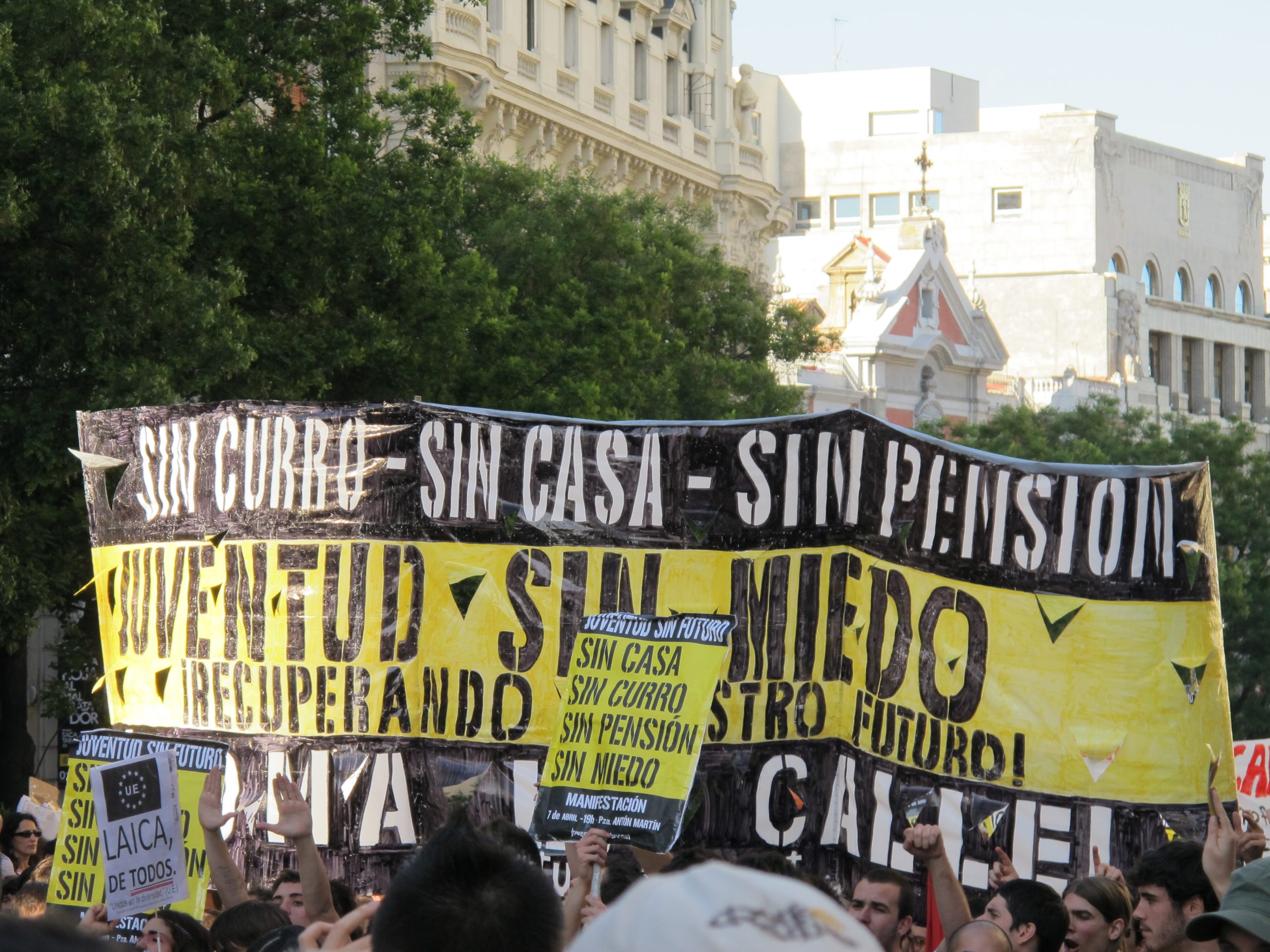
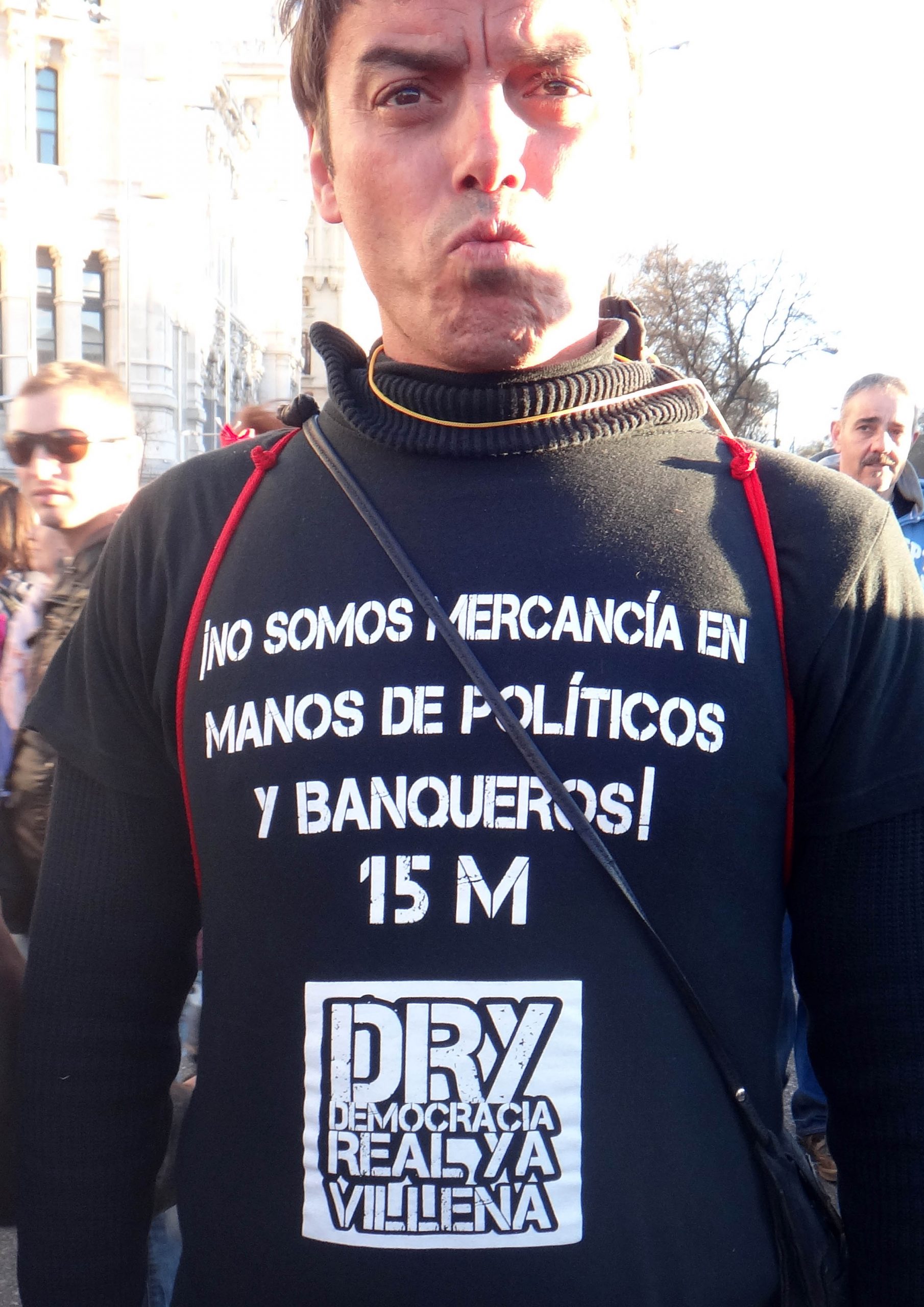
CULTURAL RESOURCES
Although the ‘Movimiento de los indignados’ disappeared without having achieved any tangible goals, it left behind the seeds for future social movements called ‘Mareas’ (‘Tides’). Each one is focused on a different public sector and it is identified by a different colour. The protesters rally wearing t-shirts in the specific colour. The 15-M also inspired the creation of a new left-wing political party, Podemos, in 2014.
LAS MAREAS
Marea Amarilla, en defensa del sistema público de bibliotecas.
Marea Azul, contra la privatización del agua pública.
Marea Blanca, en defensa de la sanidad pública.
Marea Granate, en defensa de los españoles residentes en el extranjero.
Marea Naranja, en defensa de los servicios de atención social.
Marea Negra, funcionarios de administración y servicios generales contra los recortes.
Marea Roja, en defensa de los desempleados y por los servicios públicos de empleo.
Marea Verde, en defensa de la educación pública.
Marea Violeta, contra los recortes en políticas de igualdad.
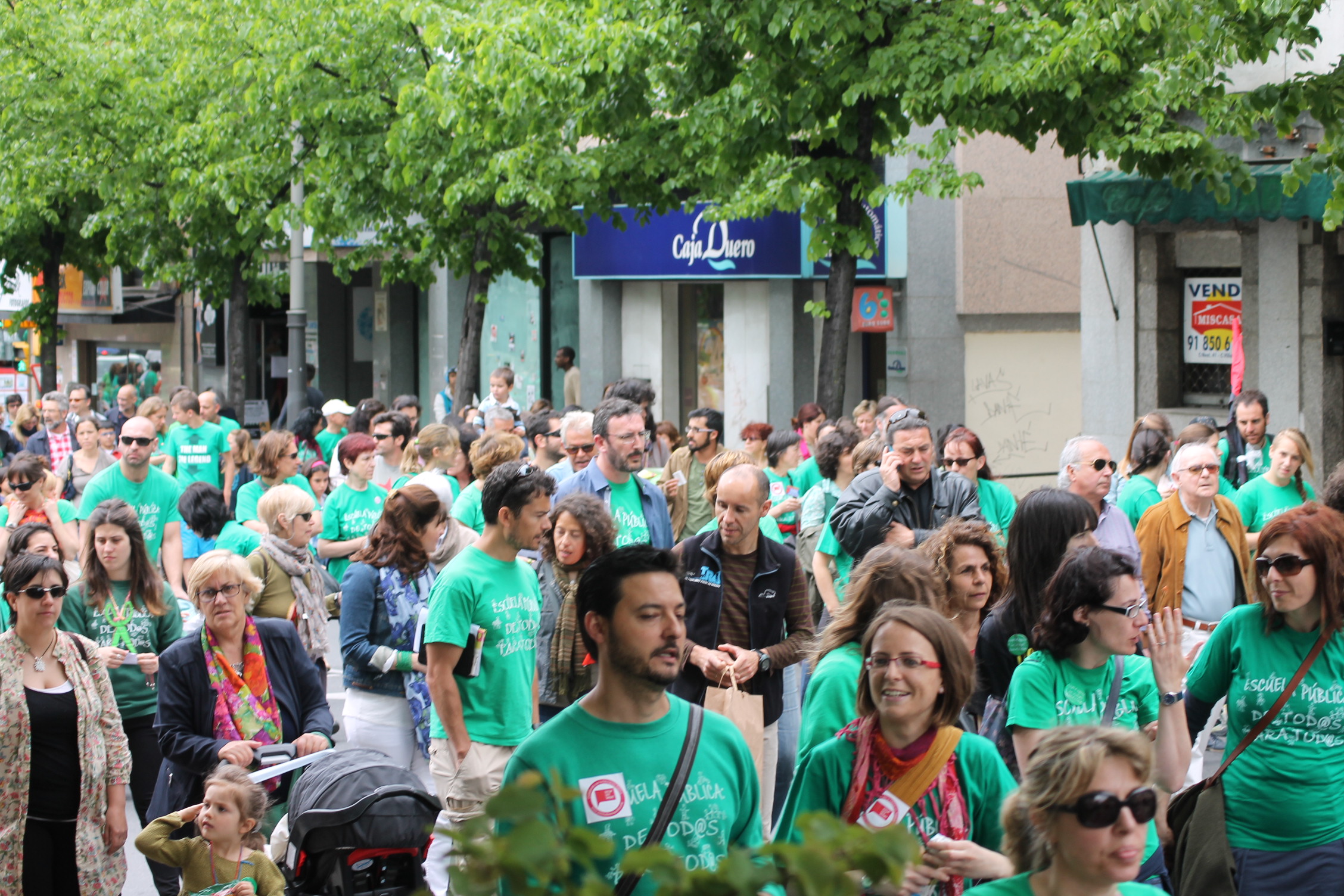
The economic crisis and the austerity measures that ensued made José Luis Rodríguez Zapatero’s Socialist government unsustainable. He called a general election for November 2011, several months before the end of his mandate was due.
CULTURAL RESOURCES
Zapatero: un reformista vencido por la crisis (in Spanish)
PSOE (2004-2011): REFORMAS SOCIALES Y EL PRINCIPIO DE LA CRISIS ECONÓMICA
Con la victoria electoral del PSOE José Luis Rodríguez Zapatero se convirtió en presidente del gobierno. Empezó a poner en marcha una serie de reformas consecuentes con su eslogan electoral: “el nuevo talante”. Su primera acción como líder del gobierno fue traer de vuelta a los soldados españoles que habían sido enviados a Irak.
La cuestión de igualdad de género era prioritaria para Zapatero. Formó un gobierno paritario. Importantes carteras ministeriales fueron a parar a manos de mujeres.
EL NUEVO TALANTE: REFORMAS SOCIALES
La primera ley de Zapatero en 2004 fue la Ley Integral contra la Violencia de Género para responder a una lacra social que hasta ahora había sido ignorada. Desgraciadamente, este problema es similar o incluso peor en el resto de Europa y del mundo. Cada año son asesinadas en España una media de 50 o 60 mujeres a manos de sus maridos, exmaridos, parejas y exparejas. Una de cada tres de estas víctimas son extranjeras.
Esta ley hizo posible la creación de más de 100 juzgados especiales para este tipo de delito. Así, se acelera la expedición de órdenes de alejamiento y dispositivos de seguimiento electrónico. Además, los casos se juzgan más rápidamente. Hay ayudas especiales para las mujeres que necesiten cambiar de residencia para huir de su agresor. Las mujeres inmigrantes irregulares que sufran violencia de género tienen prioridad a la hora de recibir el permiso de residencia y trabajo para poder llevar una vida independiente. La ley ha introducido sentencias más severas para los culpables de este delito, así como cursos de rehabilitación para su reintegración en la sociedad.
Los detractores de esta ley alegan que es discriminatoria hacia los hombres, puesto que solo considera víctimas de violencia de género a las mujeres. El hecho es que las estadísticas indican claramente que este delito afecta mayoritariamente a las mujeres, puesto que la estructura social sigue siendo patriarcal. Es probable que esta sea la razón por la que la ley no ha reducido el número de asesinatos. Otros detractores acusan a la ley de promover denuncias falsas, pero las estadísticas muestran que el número de estas es insignificante.
En 2005 se aprobó la nueva Ley del Divorcio, que aceleraba el proceso. Las parejas casadas se pueden divorciar a partir de los tres meses de matrimonio, antes si hay violencia de género. No hace falta alegar razones ni pasar un tiempo separados. Si no hay ninguna complicación, el divorcio puede tramitarse en tan solo dos meses.
También en 2005 se hizo efectiva la Ley del Matrimonio Homosexual. España fue el tercer país del mundo en tener esta ley. La ley da plenos derechos a los matrimonios gais, incluida la adopción.
En 2006 se aprobó la Ley de Dependencia para mejorar las condiciones de las personas con discapacidad y sus cuidadoras o cuidadores. Se crearon servicios de teleayuda, cuidados domésticos y centros de día. El mismo año se creó el “cheque bebé”, una medida para promover la natalidad, que consistía en un pago de 2.500 euros a los padres de niños recién nacidos y adoptados.
En 2007 entró en vigor la Ley para la Igualdad Efectiva de Mujeres y Hombres. Su objetivo es dar forma legal a la lucha contra la desigualdad por razones de género. Contiene medidas para combatir el acoso sexual y la discriminación, especialmente en el mundo laboral. Las grandes empresas estaban obligadas a aumentar el número de mujeres en sus juntas directivas hasta llegar al 40% en 2015. Este punto no se ha logrado: las mujeres directivas representan tan solo el 10%. Sí se ha logrado tener un 40% de representación femenina en las listas electorales de los partidos políticos, como contemplaba la ley.
La ley también promueve la igualdad a la hora de la crianza de los hijos e hijas. Se introdujo el permiso de paternidad de 2 semanas con la intención de ir extendiéndolo progresivamente. En 2021 el permiso de paternidad se fijó en 16 semanas, con lo que ha quedado equiparado con el de maternidad.
La nueva y polémica Ley del Aborto entró en vigor en 2010. La anterior ley de 1985 estaba basada en supuestos. El aborto solo se permitía en casos de violación, peligro físico y psíquico para la madre o malformación del feto. La nueva ley se basa en plazos. El aborto está permitido hasta la semana 14 de embarazo sin restricciones, y hasta la semana 22 en caso de peligro para la madre o malformación del feto. Las mujeres menores de edad de 16 y 17 años no necesitan el permiso de los padres para terminar su embarazo no deseado, aunque sí es necesario que uno de los padres o tutores legales esté informado.
MEMORIA Y JUSTICIA
En 2007 se aprobó la Ley de la Memoria Histórica, de la que ya hemos hablado. Fue rechazada por el partido de la oposición, el PP.
El pasado todavía tenía más secretos. Entre 2009 y 2010 estalló el escándalo de los bebés robados. Se cree que más de 300.000 recién nacidos fueron robados a sus padres y vendidos a otras familias entre 1940 y 1990. Este tráfico de bebés empezó durante el franquismo para quitar los niños a sus padres por motivos políticos y dárselos a padres que eran católicos y franquistas, pero continuó durante el periodo democrático. El escándalo involucra a médicos, comadronas, enfermeras, sacerdotes y monjas. Muchos de estos casos han prescrito o los culpables ya han muerto por lo que va a ser difícil conseguir justicia.
ETA: EL FINAL SE ACERCA
ETA declaró un alto el fuego permanente en 2006 y Zapatero se mostró abierto al diálogo. Cuando ETA hizo estallar una bomba en el aparcamiento del aeropuerto de Madrid matando a dos personas de nacionalidad ecuatoriana, Zapatero dio por terminado el alto el fuego. La izquierda abertzale, que ya no veía futuro a la lucha armada, empezó a trabajar para conseguir la paz y organizó una conferencia en San Sebastián con importantes mediadores internacionales, tales como el anterior secretario general de la ONU Kofi Annan, el ex primer ministro irlandés Bertie Ahern y el líder del partido republicano irlandés Sinn Féin, Gerry Adams. Tres días después ETA anunció el “cese definitivo de su actividad armada”.
EL PINCHAZO DE LA BURBUJA
En 2008 la economía mundial entró en recesión. En los EEUU las llamadas “hipotecas basura” desencadenaron una crisis crediticia que acabó con la importante institución financiera, Lehman Brothers. Otros bancos fueron rescatados con dinero público. Algunos países de la zona euro también tuvieron que ser rescatados por el BCE (Banco Central Europeo) y el FMI (Fondo Monetario Internacional) al no poder pagar su deuda pública; por ejemplo, Irlanda en 2010. Hasta 2010 Zapatero no admitió que la economía española también estaba en crisis.
España entró en un periodo de bonanza económica a partir de mediados de la década de los 90 gracias al boom de la construcción. Los tipos de interés bancarios estaban muy bajos y era muy fácil conseguir una hipoteca o un préstamo. Esto provocó una gran especulación. Los precios de la vivienda se dispararon y se creó una burbuja inmobiliaria. Esta burbuja explotó cuando la gente dejó de comprar propiedades y las promotoras se arruinaron. Muchas personas perdieron su trabajo y ya no podían pagar la hipoteca. Empezaron los desahucios. El índice de desempleo pasó del 8% en 2007 al 20% en 2010. Muchos jóvenes, especialmente con títulos universitarios, emigraron al extranjero en busca de un empleo.
Zapatero se vio obligado a aplicar medidas para promover la movilidad en el mercado laboral. Se aprobó una reforma laboral que facilitaba el despido y penalizaba los contratos indefinidos. Las medidas de austeridad, es decir, recortes en el gasto público no tardaron en llegar. Se eliminó el cheque bebé, se redujo el salario de los funcionarios, se congelaron las pensiones, se recortó el gasto farmacéutico en la sanidad pública y subió el IVA.
Ahora ya no hacían falta inmigrantes. Además, muchos de ellos se habían quedado sin trabajo. En 2005 Zapatero había dado una polémica amnistía a los inmigrantes indocumentados que residían en España. 700.000 personas pudieron conseguir los papeles necesarios para buscar un empleo legalmente. Las contribuciones a la Seguridad Social aumentaron en 1.000 millones de euros ese año. Cuando la economía empezó a ralentizarse, el gobierno decidió facilitar la vuelta de inmigrantes a sus países. Para ello introdujo el Plan de Retorno Voluntario a finales de 2008. Este plan permitía a los inmigrantes parados cobrar el subsidio de desempleo en dos plazos: el 40% en España y el 60% en su país de origen. Para ello, tenían que renunciar a su permiso de residencia y trabajo y no regresar a España antes de 3 años.
15-M: EL MOVIMIENTO DE LOS INDIGNADOS
El 15 de mayo de 2011 hubo una serie de manifestaciones en varias ciudades españolas. Los manifestantes protestaban contra los recortes en los servicios públicos: sanidad, educación, subsidios. Culpaban a los bancos del desastre económico. Algunos de los manifestantes en Madrid decidieron acampar en la Puerta del Sol. Estuvieron allí casi un mes y formaron asambleas para discutir problemas sociales y formas de solucionarlos sin perjudicar a los más débiles. Pedían una democracia participativa. Este movimiento social se llamó el 15-M o Movimiento de los indignados. Fue la inspiración de los diferentes movimientos ‘Occupy’ en el mundo.
El Movimiento de los indignados desapareció, pero en su lugar aparecieron diferentes movimientos sociales de protesta conocidos como ‘mareas’, cada una con su color y sector público específico. También fueron el origen del nuevo partido de izquierdas, Podemos, fundado en 2014.
La crisis económica y los recortes acabaron por hundir al gobierno de Zapatero, que tuvo que adelantar las elecciones generales varios meses.
Media Attributions
- Jose Luis Rodriguez Zapatero – World Economic Forum Annual Meeting Davos 2010
- 5814632266_325fffa659_b
- 6399409775_0055f1a0f1_o
- ETA deja las armas
- Marea Verde
